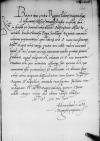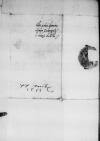Letter #1026
Bona Sforza to Ioannes DANTISCUSVilnius, 1533-10-31
| received [Löbau (Lubawa)], 1533-12-20 Manuscript sources:
Prints:
| ||||||
Text & apparatus & commentary Plain text Text & commentary Text & apparatus
[Reverendo in Ch]risto Patri, domino
Reverende in Christo Pater, sincere nobis dilecte.
Proficiscente istuc venerabili
Quod reliquum est, volumus, ut Paternitas Tua tamquam creatura nostra, pro auctoritate officioque suo operam det, quo conventus iste particularis sic instruatur, ut demum generalis citra magnam difficultatem cum honore serenissimorum
Bene valeat.
Datae
Ad mandatum serenissimae maiestatis reginalis proprium

